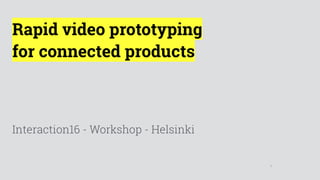
Rapid video prototyping for connected products
- 1. 1 Rapid video prototyping for connected products Interaction16 - Workshop - Helsinki
- 2. 2 Hello! Tom Metcalfe Martin Charlier @tommetcalfe @marcharlier
- 3. 3 What we’ll do today • An introduction to video prototyping (20 min) • Prototyping time (1h 15min) • Demos and discussion (25 min)
- 5. 5 “PROTOTYPE” An experiment designed to answer specific questions.
- 6. 6
- 8. 8 What are the tech challenges we will face? Can we actually make this work with the tech we have? Will it meet the requirements? Would people use this? How would it have to work to be desirable? Should we build this at all? What would it feel like to use this? PROTOTYPE EXPERIENCE PROTOTYPE
- 9. 9 Building the thing right. PROTOTYPE EXPERIENCE PROTOTYPE Building the right thing.
- 10. 10 negligiblesignificant Cost hours or daysweeks Time many & roughfew & precise Answers PROTOTYPE EXPERIENCE PROTOTYPE
- 11. 11 ELECTRONICS PROTOTYPING Even electronics prototyping platforms can sometimes distract and waste time. “Uh-oh! I’ve just spend an entire day getting a WiFi library to work.”
- 12. 12 Prototyping techniques Media from the future Storyboards Physical props & acting out Wizard of Oz Video prototypes
- 13. 13 Prototyping techniques Media from the future Storyboards Physical props & acting out Wizard of Oz Video prototypes
- 14. 14 Prototyping techniques Media from the future Storyboards Physical props & acting out Wizard of Oz Video prototypes Credit: Robert André
- 15. 15 Prototyping techniques Media from the future Storyboards Physical props & acting out Wizard of Oz Video prototypes Credit: D-LABS
- 16. 16 Prototyping techniques Media from the future Storyboards Physical props & acting out Wizard of Oz Video prototypes Credit: Ericsson Labs, Marcus Nyberg
- 17. 17 Prototyping techniques Media from the future Storyboards Physical props & acting out Wizard of Oz Video prototypes
- 18. 18 These are NOT video prototypes.
- 19. 19 It’s not (just) about the video! 80% (The process) • Rapid iteration and decision making. • Exploration across physical context, multiple devices, time and space. • Forces you to think in a time-based sequence of events - a user journey. • Acting out: Empathy with the user. How it might ‘feel’ like using this. 20% (The video) • It’s self-explanatory and shareable. • Film is a widely understood medium that is easily digestible. • Less ‘loss in translation’, relies less on imagination of others. • It lets viewers judge plausibility (they get a degree of empathy).
- 20. 20 30 minute prototype for a connected herb garden sensor. This was a video
- 21. 21 Connected instrument w/ play-along lessons Credit: Alexandros Kontogeorgakopoulos and Ant Mace / From a workshop run by Tom Metcalfe This was a video
- 22. 22 Sketch-A-Move: Slightly more elaborate. Both a demonstration and an exploration. http://www.superflux.in/work/sketch-move This was a video
- 23. 23 Sketch-A-Move: Behind the scenes http://www.superflux.in/work/sketch-move Capture imagination and inspire the team Matthias Kranz, et. al http://www.eislab.fim.uni-passau.de/files/ publications/2006/SketchAMove_preprint.pdf
- 24. 24 Stills compositions with narration More info: http://www.cooper.com/journal/2008/12/economizer This was a video
- 25. 25 A storyboard or video prototype can guide the tech requirements More info: http://www.cooper.com/journal/2008/12/economizer Design requirements Design requirements Design requirements Design requirements
- 26. 26 Levels of exploration Value proposition Context of use Interaction “is there value in this idea?” “where are the key challenges?” “would using this on public transport be problematic?” “would this work in a kitchen environment?” “how would the interface have to work?” “what is the right gesture for this?”
- 27. 27 Levels of exploration Value proposition Context of use Interaction Convince investors Test desirability with potential users Articulate a joint vision Document design requirements Iterate and refine your design
- 28. 28 How To guide
- 31. Substitution 31 The ‘Stop Trick’ (or ‘Substitution splice’) Recording STOP START • Don’t move the camera. • Keep the same shot. • Only move the parts that change.
- 32. 32 Recording This was a video
- 33. 33 Substitution This was a video
- 34. 34 Things to know about Instagram • Press and hold to record. • 15 seconds maximum - keep that in mind. • Think 5-6 interactions maximum (2 seconds per shot). • Plan your shots (maybe a quick storyboard). • Prototype interface: Works best if actor and camera are the same person. (Stop trick technique) • Split across multiple videos if you want a longer story.
- 35. 35 • Technology details • Lack of user insight • The quality of the idea / ideation • What question you set out to answer? • Have you answered it? • The answer could be ‘it doesn’t work’ but we’ll want to know why. DON’T GET TOO HUNG UP ON WE’RE INTERESTED IN
